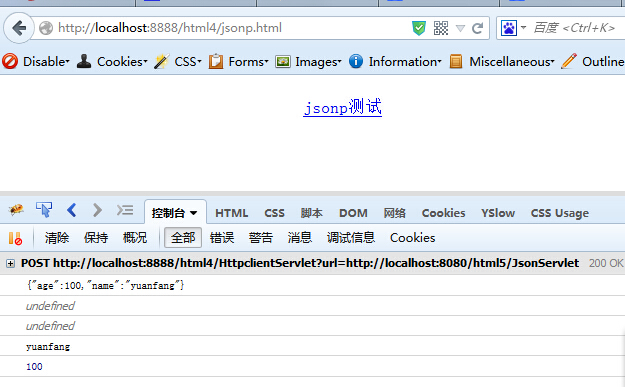使用Httpclient来替代客户端的jsonp跨域解决方案
最近接手一个项目,新项目需要调用老项目的接口,但是老项目和新项目不再同一个域名下,所以必须进行跨域调用了,但是老项目又不能进行任何修改,所以jsonp也无法解决了,于是想到了使用了Httpclient来进行服务端的“跨域”来替代jsonp的客户端跨域方案。
上一篇博文中,详细剖析了jsonp的跨域原理,本文使用Httpclient来替代jsonp的客户端跨域方案。
先去 http://hc.apache.org/downloads.cgi 下载最新版httpclient。解压tutorial文件夹中有html和PDF的使用介绍。
下面实现从8888端口的html4项目中跨域访问8080端口的html5项目中的JsonServlet:
1)在html4中建立一个中间代理servelt和一个工具类,工具类代码如下:
| 1 2 3 4 5 6 7 8 9 10 11 12 13 14 15 16 17 18 19 20 21 22 23 24 25 26 27 28 29 30 31 32 33 34 35 36 37 38 39 40 41 42 43 44 45 46 47 |
|
?中间代理servlet代码如下:
| 1 2 3 4 5 6 7 8 9 10 11 12 13 14 15 16 17 18 19 20 21 22 23 24 25 26 27 28 |
|
?html4项目中的访问页面代码如下:
| 1 2 3 4 5 6 7 8 9 10 11 12 13 14 15 16 17 18 19 20 21 22 23 24 25 26 27 28 29 30 31 32 33 34 35 36 37 38 |
|
上面通过:url=http://localhost:8080/html5/JsonServlet 将我们最终要跨域访问的url地址传给自己服务器下的 HttpclientServlet. 然后在 HttpclientServlet?中使用httpclient访问 跨域 url? 中的servlet,成功之后,将返回的结果返回给客户端。
html5项目中被 跨域 访问的servlet代码如下:
@WebServlet("/JsonServlet")
public class JsonServlet extends HttpServlet
{
private static final long serialVersionUID = 4335775212856826743L;
protected void doPost(HttpServletRequest request, HttpServletResponse response)
throws ServletException, IOException
{
User user = new User();
user.setName("yuanfang");
user.setAge(100);
Object obj = JSON.toJSON(user);
System.out.println(user); // com.tz.servlet.User@164ff87
System.out.println(obj); // {"age":100,"name":"yuanfang"}
response.getWriter().println(obj);
}
protected void doGet(HttpServletRequest request, HttpServletResponse response)
throws ServletException, IOException
{
this.doPost(request, response);
}
}
启动8888和8080端口的tomcat,访问 http://localhost:8888/html4/jsonp.html ,结果如下:

我们注意到第二和第三项都打印的是 undefined ,这是因为 中间代理的 HttpclientServlet,使用的是直接输出流的方式,所以最终返回的结果不是Json对象,而是字符串,所以需要使用?var user = JSON.parse(data);?来进行解析成 javascript对象就可以,所以第四和第五项都正常输出了结果。
如果想返回的是json对象,加一句代码?response.setContentType("text/json;charset=utf-8");?就可以:
| 1 2 3 4 5 6 7 8 |
|
这样的话,浏览器在看到 contentType: "text/json;charset=utf-8" 时,它的js执行引擎会自动帮助我们将字符串解析成json对象。也就是相当于自动调用了 JSON.parse(data) 的效果。
本文来自互联网用户投稿,该文观点仅代表作者本人,不代表本站立场。本站仅提供信息存储空间服务,不拥有所有权,不承担相关法律责任。 如若内容造成侵权/违法违规/事实不符,请联系我的编程经验分享网邮箱:chenni525@qq.com进行投诉反馈,一经查实,立即删除!
- Python教程
- 深入理解 MySQL 中的 HAVING 关键字和聚合函数
- Qt之QChar编码(1)
- MyBatis入门基础篇
- 用Python脚本实现FFmpeg批量转换
- mac上使用 Downie 下载网页视频
- Halcon计算最小外接矩形Smallest_rectangle2
- C语言---井字棋(三子棋)
- 经典文献阅读之--Vision-based Large-scale 3D Semantic Mapping...(自动驾驶的大规模三维视觉语义地图的构建)
- Nginx+FDFS 配置断点续传实现过程指导
- 《二叉树》——2
- 剑指Offer 队列&栈题目集合
- SolidWorks 2023和2024版如何安装插件MD迈迪工具集V6.0下载安装教程
- Kafka使用总结
- MySQL 大数量left join 太慢语句拆分的一种办法